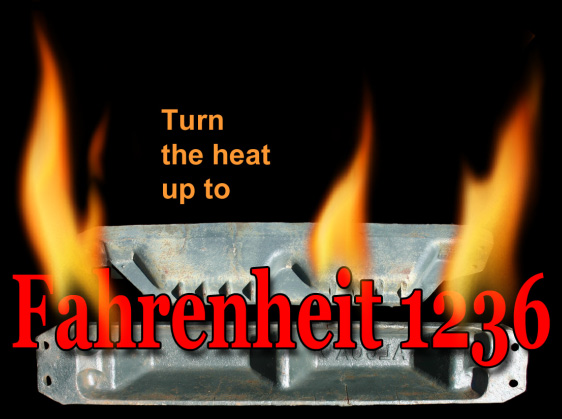

and aluminum melts...
During the salvage process it was critical for Kingman's three furnaces to be kept near
that temperature so other metals with higher
melting points wouldn't 'dilute'
the final product.
Even though their ultimate fate was yet to be determined, the planes' dismantling process started immediately upon their arrival at Kingman, beginning with minor, loose items
being extracted right on the flightline.
Later, with their fate sealed and while they were still parked in rows out in the desert, larger, more complicated things like propellers, engines and instrument panels were
recklessly removed, effectively rendering the once-proud aircraft into maligned, lifeless carcasses.
When it was their turn, one by one each fighter and bomber was ingloriously dragged back across the desert...

...to a final staging area, where even more components were yanked, such as undesirable solder-containing wiring harnesses.
First the valuable then the problem-causing elements eliminated, a shell-of-a-plane was pushed under the Blade that dropped however many times that particular aircraft
took to render it into more manageable chunks... 3 or 4 for a tiny P-40 and
perhaps a couple of dozen or more to break down a giant B-32.
Smoke pouring from a Kingman furnace in the background, the 100th Bomb Group's LITTLE DINAH (USAAF Serial Number 43-38314) is rudely pushed ever closer to the Blade. Now stripped of her superfluous equipment, momentarily her carcass will be transformed from a once-fearsome weapon of war into an unrecognizable puddle of aluminum:

Workers would hook a cable onto landing gear and flip planes onto their back so the struts & tires could be removed with relative ease, which were then deposited elsewhere for further dismantling.
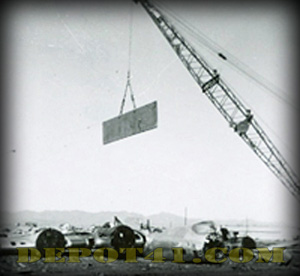
I can't think of a less dignified way for these gallant warriors to have ended up . . .
Finally, a specially-rigged bulldozer pushed the aluminum chunks into furnaces
and the flames were turned up:
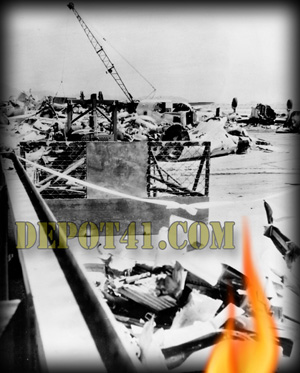
Here's a stainless steel B-17 Engine Cowl Panel from the guillotine area (seen above) that was recovered shortly after the Wunderlich operation ended - its type of metal being the sole reason for a continued existence...

... and displaying a 'pancake' form after having been driven over repeatedly by heavy equipment.
Once the aluminum became molten, the silvery liquid naturally wanted to flow downhill, so a swinging trough was used to direct it into molds of varying shapes and sizes. Waiting only long enough for them to barely harden, the larger ingots - affectionately called 'pigs' - were pulled from molds and stacked into piles using another crane.
Recognize your favorite bomber below?
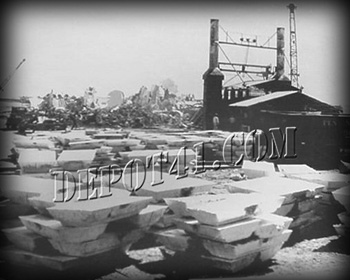
Below are actual Kingman furnace bricks,
made by 3 different manufacturers:

An interesting piece of equipment devised at Kingman consisted of a series of 6" X 34" molds attached to an inclined conveyor belt. Its lower end placed by the molten aluminum trough and the other pointed toward a new stack or into a waiting railcar, the conveyor would move slow enough as to allow the liquid metal to barely harden in each mold while they approached gloved handlers, whose job it was to stack these solid, but still extremely-hot ingots into orderly piles.
Through the magic of computers, the logo on one of those conveyor molds (two of which are pictured at the top of this page) is mirrored here to show the major recipient of all this
aluminum:

ALCOA = Aluminum Company of America
After WWII, with a nationwide surplus of this lightweight material, companies sprang up to manufacture scores of wonderful things like artistic furniture and all sorts of colorfully
anodized kitchenware. Aluminum pitchers with their matching drinking tumblers were very popular, and also very cool.
Remember them? I sure do!
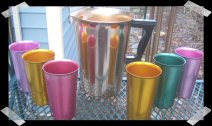
It may be the most abundant metallic element
on earth, but because its refining process is so costly, aluminum has steadily remained
near the top of the recycling list.
So you see, those wondrous & historic WWII planes aren't really gone after all, today they just look a bit different!

Scrutinizing the background of a much larger image recently ...
... who is that behind the furnaces?
Why, if it isn't the now-famous B-24 Liberator
DRAGON AND HIS TAIL !!!
Note the 43rd Bomb Group's diagonal Slash on the vertical stabilizer and DRAGON's green tail swooping over the Star & Bars:
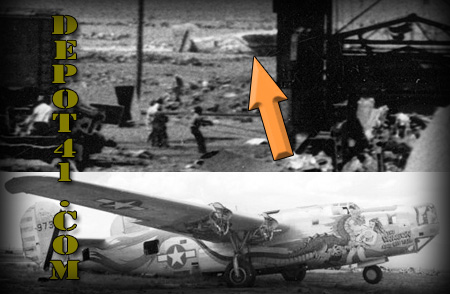
Literally pulled from the Pack, this closeup shows where Wunderlich workers ended up putting her on display after selecting the bomber for its exceptional & colorful artwork. Reportedly, she was the very last Kingman plane to be melted.
1946 MOHAVE MINER article headline:
"KINGMAN TO GET LIBERATOR FOR DISPLAY"
I'm not sure where this noble idea originated, but it was never carried through and not a single B-24 is known to have survived Kingman.

Project "M"
PROBLEM:
What to do with hundreds and hundreds of pounds of aluminum parts & pieces from virtually every type of plane at Kingman that collectors, restorers and museums over the past 30 years have shown little or no interest in?
SOLUTION:
A two-pronged objective to:
a) Pay tribute to the Planes in a unique fashion
b) Generate funds for research and a museum
...Both of which will require heating the
ALCOA molds once again after 60+ years.
Around these parts, it's known as
Project "M"
Stay tuned.....
photo credits this page:
Mohave County Historical Society,
Carlos Elmer,
Depot 41 Photo Archive
© 2007 - 2025 Depot 41 All Rights Reserved